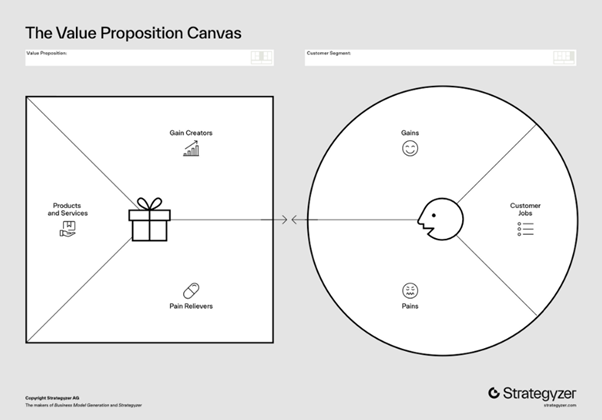Value Proposition Canvas
In a previous blog article (which you can find here), we discussed the benefits of uncovering the unique motivations, frustrations, and priorities of stakeholders involved—whether directly or indirectly—in a project. To achieve this, we introduced the Jobs-to-be-Done (JTBD) theory, offering a human-centric perspective for understanding stakeholder motivations that drive decision-making. What if I told you there’s a tool that not only integrates seamlessly with the JTBD theory but also extends its reach? A tool that helps identify the precise components of a project that align with stakeholder motivations? Enter the Value Proposition Canvas (VPC).

Similar to the JTBD theory, the Value Proposition Canvas revolves around a human-centric approach. Originally designed to assist organisations in grasping which aspects of their products and services resonate with clients, this strategic tool identifies the pains, gains, and jobs (yes, the JTBD concept!) of target customers. In the realm of project management, envision the project manager as a bridge builder, connecting stakeholder aspirations (akin to customers) with the project’s intended outcomes (akin to the service). The fusion of JTBD and VPC facilitates seamless bridge construction.
The Value Proposition Canvas
An organisation’s value proposition succinctly explains ‘why’ buyers should choose or buy its products or services over alternatives. As a visual tool, The Value Proposition Canvas guides the design of this value proposition from a customer-centered standpoint, allowing customers to articulate the ‘why’ instead of us assuming it. Developed by Alexander Osterwalder and Yves Pigneur as part of the Business Model Canvas framework, the VPC aims to comprehend the alignment between what a product or service offers and what the customer genuinely desires (the ‘why’).

Figure 1- The Value Proposition Canvas, a framework created by Alexander Osterwalder and Yves Pigneur. Further details can be found in the “Value Proposition Design” book published by Strategyzer.
The framework comprises two main sections:
1. Value Map (Left – Square): On the other side of the canvas, the value map outlines how the product or service addresses the needs and desires identified in the customer profile. It breaks down the key features, experiences, and attributes contributing to fulfilling customer needs. The value map spotlights the unique value the product or service brings to the table.
2. Customer Profile (Right–Circle): This segment delves deeply into understanding customer or stakeholder segments. It helps address questions such as: What are the specific needs, pains, and gains of these segments? What are their aspirations, challenges, and emotional triggers? The customer profile acts as a window into the minds of those being served.
Recalling our healthcare organisation example from the JTBD article, let’s apply the Value Proposition Canvas.
Applying the Value Proposition Canvas
As we explored in the previous article, the project aimed to implement a new electronic medical system. Utilising the JTBD framework, we unearthed that doctors aim to save time through streamlined patient record management. Nurses seek seamless inter-departmental coordination for up-to-date patient treatment information, and administrative staff desire easily accessible information to ensure precise communication with health insurers. With the VPC, project managers can now expand the stakeholders needs by identifying challenges and aspirations.
For each stakeholder group (doctors, nurses, administrative staff), we outline both their gains and pains. This paints a comprehensive picture of what they desire and what they aim to avoid. Here are some of our stakeholders’ challenges/pains: Doctors want to avoid spending over ~30 minutes per patient to prevent surgery delays. Nurses, on the other hand, don’t want inaccurate or unavailable patient treatment information that can cause complications. And administrative staff fear miscommunication that leads to unauthorised patient treatments.
With that in mind, we can focus on how the project will address the pains by looking at the Value Map. For doctors, the electronic medical records system emphasises user-friendly interfaces and efficient record retrieval to reduce time spent per patient. For nurses, the system introduces a direct chat feature to facilitate communication between departments, ensuring accurate and up-to-date patient treatment data. With admin staff, the solution includes features that display the name of the doctor or nurse who inputted patient information, guaranteeing seamless and accurate communication with healthcare providers and insurers.
Conclusion
Just as JTBD focuses on finding the right product or service for a specific job, the Value Proposition Canvas seeks alignment between customer pains/gains and the value provided by the product. When this is adapted to project management, the project itself becomes the offering. By delineating the VPC of a project, project managers gain the insight to truly comprehend the fit between stakeholder needs and project outcomes.
By amalgamating these two frameworks, project managers can skilfully steer project delivery that resonates deeply with stakeholders. This fosters meaningful collaborations and ultimately leads to project success. The Value Proposition Canvas serves as a guiding compass for aligning the project’s course with the motivations that drive its stakeholders.
Did you enjoy this article? Explore more topics on our Experience page.
